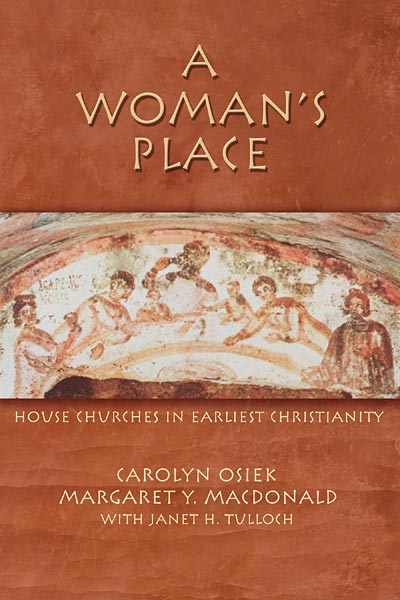A Woman’s Place: House Churches in the Earliest Christianity
 Carolyn Osiek and Margaret Y. MacDonald with Janet M. Tulloch, A Woman’s Place: House Churches in the Earliest Christianity (Minneapolis: Fortress, 2005), vi+ 345 pages, ISBN 9780800637774.
Carolyn Osiek and Margaret Y. MacDonald with Janet M. Tulloch, A Woman’s Place: House Churches in the Earliest Christianity (Minneapolis: Fortress, 2005), vi+ 345 pages, ISBN 9780800637774.
Carolyn Osiek, Charles Fischer Catholic Professor of New Testament at Brite Divinity School of Texas Christian University, and Margaret Y. MacDonald, Professor of Religious Studies at St. Francis Xavier University, have created a work that examines the day-to-day life of the women in the early church. They cover a variety of topics that would have affected every woman: marriage, birth, child rearing, childhood, motherhood, wet nurses, nannies, slaves, wives, widows, and grandmothers. Chapter 1 introduces three views that are commonly used to examine women in the early church: patriarchy vs. the discipleship of equals, public vs. private, and ascetic vs. domestic life. They also discuss basic activities of the house church such as hosting the assembly, education, communication, socialization, charity, evangelization, and mission.
Chapter 2 focuses on wives noting that the Biblical ideal was not often reality. Evidence for this period regarding Christian women is fragmentary. Despite this, the authors insert this evidence into an “imaginary scene (18) based on what we know of a typical Roman family.” The chapter examines Colossians and Nympha’s role, on Prisca, Ananias and Sapphira as well as other ancient texts. Chapters 3 and 4 cover birth, childcare, and raising children in the house church. Topics include abortion, infanticide, exposure, nursing, and mortality rates for both mother and child. Besides using Roman medical texts the authors also, use the writings of Plutarch, John Chrysostom, The martyrdom of Pertpetua and Felicitas, the life of Macrina and the infancy gospel of Thomas.
Chapter 5 deals with the female slave and builds on the work of Jennifer Glancy (Slavery in Early Christianity) and J. Albert Harrill (Slaves In The New Testament: Literary, Social And Moral Dimensions) to illustrate the problems of Christian female slaves and the church’s problem with them. This chapter is loaded with Roman law, rabbinic writings and non-Christian authors. The sixth chapter examines Eph. 5:22-33 using two points of view: the first as a document against Roman ideology and the second as an apologetic ideal representing the church. Asking if the injunction to marry as an option could have been a way for women to wield influence in the house church is the topic of chapter 7.
Category: Church History, Fall 2008, Pneuma Review


